Site menu:

August 2012 Newsletter
Chasing Blackwits.
Liverbird Bird Watching Cruises.
July Bird News.
Forthcoming Events.
Latest Newsletter.
Following colour ringed migratory shorebirds around Europe.
Part 1: Chasing Blackwits.
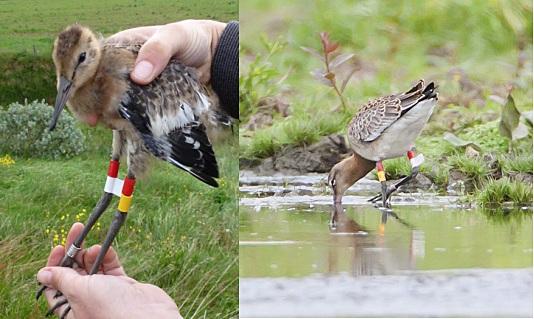
and seen again on August 25th 2011 at West Kirby (Right) © Matt Thomas
Also seen at Talacre (Sep 2011), Mersey Estuary (Mar 2012) and Burton in May and July 2012
By Matt Thomas
A few years ago I was supervising a young student on their work
experience at Wirral Country Park when she mentioned she was interested
in seeing the wading birds that the Dee is famous for. I decided as a
reward for her hard work over the two week placement I would take her
to the beach on her final day to watch the birds feeding as the tide
fell.
All the usual suspects were present on the shore. We saw Knot, Dunlin,
Curlew, Redshank, Pintail, Shelduck, Oystercatcher, Black-tailed Godwit
and Richard, the author of this website!
Richard was looking at a thousand or so Blackwits feeding on the
mudflats and we joined him to scan the flock. He mentioned that one of
the Godwits was colour ringed and soon enough we located it. I had
never seen or heard of colour ringing at this point but my interest was
piqued and I listened as Richard told me that it had been ringed in
Iceland as part of Operation Godwit.
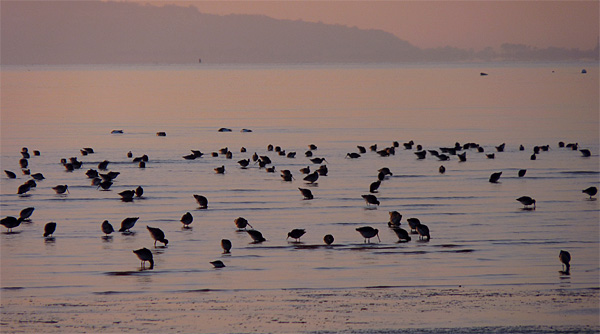
The Black-tailed Godwits found on the Dee belong to the subspecies islandica. They breed in Iceland and winter in the British Isles, France, south to Portugal and possibly Morocco. They are ringed in Iceland, Portugal, England, Ireland and France by local ringing groups and researchers from the University of East Anglia and institutions in Iceland in a project called Operation Godwit.
In contrast to many wader populations Icelandic Black-tailed Godwit numbers are rising and by studying these birds we might be able to get a clearer understanding of what conditions shorebird populations need to flourish and this knowledge can then be used to inform the conservation strategies used for other species.
Marking birds with unique colour ring combinations is allowing researchers to track individual birds around Europe. This has lead to the calculation of mortality rates, yielded new information on wintering areas, site faithfulness, range expansion and migration timings.
After several years of contributing sightings I was lucky enough to be invited along on an expedition to Portugal in February of this year to take part in the capture and ringing of some Blackwits. Naturally I enthusiastically accepted the invite and was soon headed south!

Not one we normally see on the Dee Estuary!!
The mudflats looked almost identical to those I was used to surveying on the Dee, with a similar list of species plus some that seemed quite exotic to one used to scanning Thurstaston Shore. As I searched for colour ringed Blackwits the odd Lesser Flamingo would sway serenely past. Tall and elegant Black-winged Stilts shared pools with Avocets while over my head White Storks circled on rising thermals.
For several days we observed feeding flocks looking for a suitable catch site. The location was chosen, and the cannon nets set with extreme care so that the catch could be carried out with minimal risk to the safety of the birds. Only when birds were in a safe catching zone was the net fired. We caught 9 birds with our first attempt, a pleasing result. Two further catches took place after I had to return home, ringing just over 20 birds during the whole expedition.
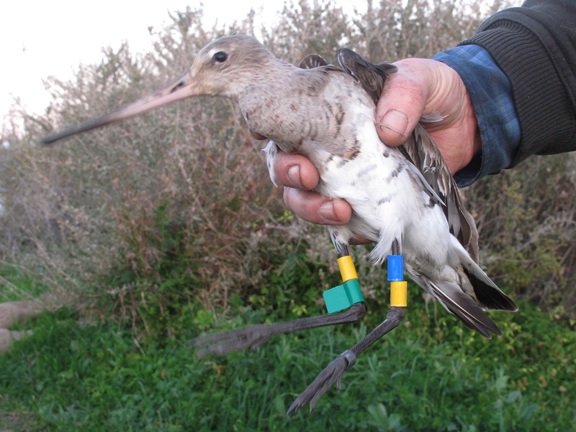
So, what has all this colour ringing told us? It has revealed much in a relatively short period. Most obvious is the faithfulness to both breeding and wintering areas. Birds will breed within yards of their nests from the previous year, and some birds will be found in the same creek of the same estuary winter after winter.
The next point is interesting from a Dee perspective. In Iceland birds are expanding their breeding range into areas that were previously thought unsuitable; however, these habitats are certainly less than ideal and have poorer nest sites and foraging. Thus birds occupying this new part of the breeding range produce young that fledge later than the birds nesting in premier habitat, and possibly have lower fitness. In effect these are “second class” Blackwits.
So where is the Dee connection? It seems that these inferior birds are the ones we see most frequently on the Dee! Birds in premier habitat often pass through the Dee early, on their way further south to more productive estuaries, often in France or Portugal. Indeed, birds ringed in Portugal are seldom, if ever seen on our local patch.
We receive the “second class” Blackwits because, as a final stimulus to fledge and become independent, adult Blackwits leave the nesting sites earlier than the chicks to fuel up for migration. The majority of adults will have left by the time the “second class” juveniles are ready to migrate and these youngsters are not able to follow the adults to Portugal and the best wintering areas. When the birds eventually set off they often stop at the first good place they find, and unaware that there is better habitat elsewhere and stay where they are. Data is still coming in and these findings may change, but it seems plausible. This could only have been deduced from the use of colour marking of individual birds.
Despite these findings these Black-tailed Godwits are still my favourite birds on our estuary and I consider them in a class of their own!
Once we had finished with the Blackwits we turned our attention to Sanderling. The International Wader Study Group is currently undertaking a worldwide study of this species. The Sanderling Project is investigating population trends, timing of migration, the routes taken and non breeding distribution. We were to colour ring as many as possible so that observers around the world have the chance to report resightings and so increase the data set required to calculate mortality etc.
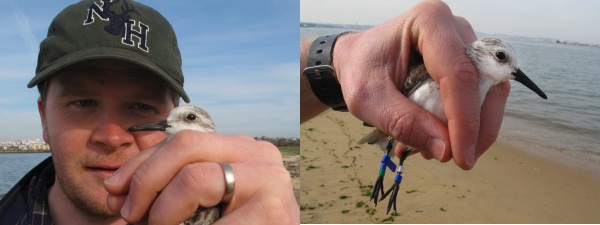
Two of the birds I helped to ring have already been resighted in the UK, one in Devon and one on the Hebredian island of Tiree. It is entirely possible that several of the birds I ringed will pass through the Dee so please; if you find a flock of Sanderling feeding on the shore take a closer look and see if any are ringed.
All sightings are vital and greatly appreciated.
Richard collates and sends off the sightings of colour ringed birds so please report the date, time, location and ring colour combination of your bird to him at
Next month: Part 2: Tangled up in Knots
By Matt Thomas.

Top of Page
RSPB Liverbird Watching and Nature Discovery Cruises
For more details and to book see the Mersey Ferries Website or ring 0151 330 1444.
Also see the RSPB Liverpool Website - http://www.rspbliverpool.org.uk/ferrypageevent.htm
Top of Page
July Bird News

Sea watching has been good, apart from the hundreds of terns mentioned above there were good numbers of Gannets with at least 200 counted on a couple of occasions off north Wirral and there were 300 to 500 Manx Shearwaters off Hoylake on the 29th. There were quite a few Arctic Skuas with at least 10 off Red Rocks on the 30th the largest number.
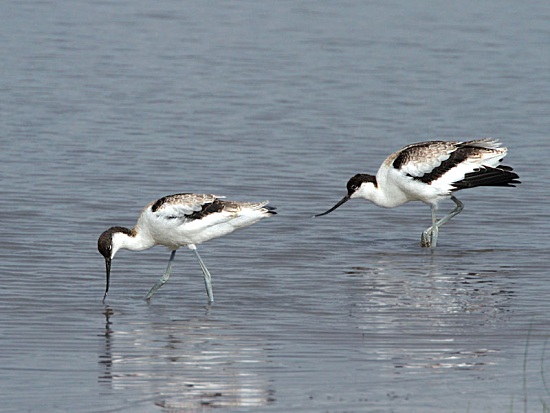
Rarities included a Great White Egret recorded on three dates, a Long-eared Owl along Denhall Lane on the 5th, a Pectoral Sandpiper at Burton Mere Wetlands on the 9th and a Hoopoe at Leasowe on the 26th. A single Osprey came over West Kirby on the 24th and single Marsh Harriers were recorded on four dates. An adult Little Gull was a good find at Parkgate on the 7th.
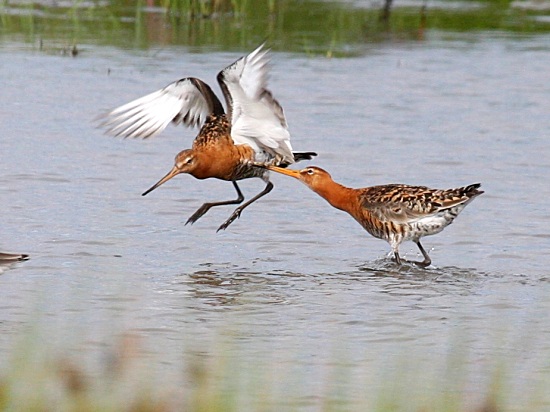
July 3rd © Paul Brady
What to expect in August
With the terns come the skuas and Arctic Skuas should be seen most days with hopefully one or two Pomarine and Great. Any fresh to strong west winds could bring in hundreds of Manx Shearwaters and Gannets and, if the wind is strong enough, some Storm Petrels with the same conditions bringing in one or two Leach's Petrels by the end of the month.
In recent years this month has been good for rare waders with Long-billed Dowitcher, Lesser Yellowlegs and White-rumped Sandpiper all seen. Greenshanks will be coming through and expect to see up to 40 or so both at Connah's Quay Nature Reserve and Parkgate, perhaps with one or two Curlew Sandpipers and Little Stints. Our more common waders will also be migrating south and some years we can get hundreds of Ringed Plover and thousands of Dunlin at Gronant, Point of Ayr, West Kirby and Hoylake. I find it fascinating watching the Black-tailed Godwits with their various plumages - juvenile, full summer, moulting and non-breeding. Gilroy Nature Park can be a very good place to see these birds along with Burton Mere Wetlands and Connah's Quay. Colour-ringing has shown that many of these 'blackwits' are on their way south to France, Portugal and Spain.
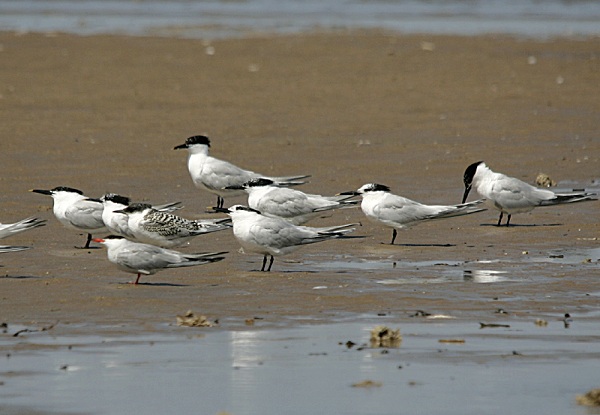
Forthcoming Events
August Highest Spring Tides (Liverpool)
Also
see Tides
page.
19th August, 13.00hrs (BST), 9.4m.
20th August, 13.37hrs (BST), 9.5m.
21st August, 14.16hrs (BST), 9.4m.
Forthcoming Events
Organised by the Wirral
Ranger Service , Flintshire Countryside Service and/or the
RSPB:
All these events and walks have bird interest, even those not
advertised specifically for birdwatching. No need to book for these
events unless specified - please check below.
Also see 2012 Events Diary.
Price: £2 for RSPB members, £5 non-members - to book
ring 0151
353 8478 or 0151 336 7681.
The mouth of the River Dee is a vital feeding ground for terns and
other seabirds before they head off on their long journeys south and
The Point of Ayr, Flintshire is one of the best places to see them.
On this walk we should see near on 1000 terns (sandwich mainly but
little, common, arctic terns all occur) roosting close in as the tide
covers up their feeding areas and forces them closer to shore.
Don't forget to bring your binoculars, telescopes and cameras.
Meet at the Smuggler's Inn car park at the end of Station Road, Talacre
(Point of Ayr).
Saturday 18th August, start at 10.30am, High tide birdwatch at
Hoylake.
You
will discover why Wirral’s foreshore is an internationally protected
site when you join the Dee Estuary Voluntary Wardens, Coastal Rangers
and the RSPB on this summer birdwatch at Hoylake. The beach should be
full of terns and returning waders, out to sea there will be a good
chance of seeing Gannets and Arctic Skuas. Meet at new Lifeboat
station Hoylake. Organised as part of Wirral’s Year of Coast and
Countryside.
High tide at 12.23pm, 9.2m. No need to book. Ring 0151 648 4371 for
more info.
Saturday 18th August, 8pm to late, Bats at Burton Mere Wetlands RSPB.
The
Cheshire Bat Group have kindly agreed to lead a guided walk around
Burton Mere Wetlands to showcase the amazing winged mammals of the
night.
The Daubenton’s bats can be spectacular feeding over the meres so book
your place early to avoid disappointment.
Cost: £2.00 to RSPB Members and £5.00 to non-members - Please
phone 0151 353 8478 to book.
Saturday 1st September, 6pm - 8pm, An Evening with Egrets
at Burton Mere
Wetlands RSPB.
Price: £2 RSPB members, £5 non-members.
Booking essential.
The
Dee Estuary is home to the largest number of little egrets in the
entire North of England and believe it or not they all roost in one
small group of trees near to Burton Mere Wetlands.
So come along
for a short talk on the trials and tribulations of little egrets in the
UK before a gentle stroll down to the Marsh Covert Hide to watch as
hundreds of egrets come "home" to roost.
This truly is one of the best wildlife spectacles at this time of year
in the north.
Places are limited so book in advance to avoid disappointment.
Cost includes a cuppa and biscuits.
Saturday 8th September, Hilbre Low Tide
Birdwatch, 8:00am start to 1:30pm latest.
Join the Rangers, the RSPB and staff from the Hilbre Bird Observatory
on this low tide birdwatching event on Hilbre Island.
Booking
essential. Phone (0151) 648 4371.
Saturday 29th September, The Big Seawatch, Hilbre.
Join
the Rangers, staff from the RSPB, Hilbre Bird Observatory and the Sea
Watch Foundation for a day on Hilbre looking for seabirds, waders and
cetaceans that inhabit our wonderful coast. We will be
staying on
Hilbre during high tide, giving us the best chance to see them with
experts on hand! There is a small charge of £1.50 for this
event
which includes tea/coffee.
Booking Essential.
Please ring (0151) 648 4371.